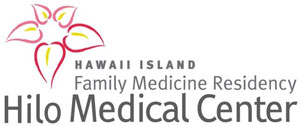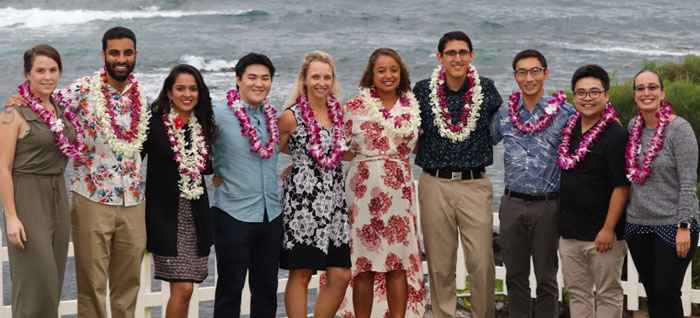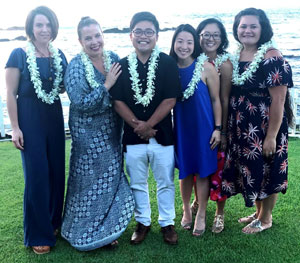Hawai'i Island Family Medicine Residency
- Need: Hawai'i is experiencing a severe shortage of family medicine physicians.
- Intervention: The Hawai'i Island Family Medicine Residency (HIFMR) program uses an interprofessional team-based approach so residents learn how to care for many types of patients in different healthcare settings.
- Results: Since 2017, HIFMR has graduated a class of 3 to 6 Board-certified family medicine physicians annually. Most graduates have remained in the state to practice medicine; those who have left have entered fellowship programs and plan to return to Hawai'i Island to practice.
Description
 Hilo
is the largest community on the rural island of Hawai'i
(also called the Big Island). While the state is
attractive to tourists and locals alike, the Big Island
struggles to recruit and retain family medicine
physicians. Geographically and culturally distinct,
Hawai'i experiences high rates of complex health issues.
With limited health infrastructure and a limited
workforce pipeline, communities remain underserved.
Hilo
is the largest community on the rural island of Hawai'i
(also called the Big Island). While the state is
attractive to tourists and locals alike, the Big Island
struggles to recruit and retain family medicine
physicians. Geographically and culturally distinct,
Hawai'i experiences high rates of complex health issues.
With limited health infrastructure and a limited
workforce pipeline, communities remain underserved.
The shortage of physicians hurts the populations who receive care at Hilo Medical Center (HMC), a safety net hospital that serves the entire east side of the island and hosts the second busiest emergency room in the state.
Hawai'i Island Family Medicine Residency (HIFMR) began in 2013 with a cohort of four residents. Fully accredited by the Accreditation Council for Graduate Medical Education (ACGME), HIFMR's team-based model provides a supportive educational environment with a robust community medicine experience in the hope that residents will stay and practice in rural Hawai'i after graduation. Residents work with other providers such as Advanced Practice Registered Nurses (APRNs), behavioral psychologists, community health workers, and clinical pharmacists to care for their patients' needs. Behavioral health is integrated into the primary care setting, allowing for scheduled as well as warm handoff visits.
With a "grow local" approach to creating a healthcare workforce, HIFMR encourages applicants with ties to Hawai'i. In the spirit of a multidisciplinary learning environment, the Hilo Medical Center-based program also hosts learners from:
- University of Hawai'i (UH) at Hilo's Daniel K. Inouye College of Pharmacy
- UH at Hilo's School of Nursing
- UH Mānoa's Nancy Atmospera-Walch School of Nursing
- Other residencies, on a short-term rotation basis
Services offered
HIFMR runs on a modified block schedule format, with at least two half-day outpatient family medicine clinics each week. HIFMR residents learn and work in varied hospital settings – from geriatrics to surgery to emergency medicine – with all ages of patients, including those with acute illnesses and chronic diseases. In addition to the usual scope of family medicine, residents learn from faculty members who also have special expertise in HIV medicine and addiction medicine.

HIFMR residents work in other communities on the island, including Kailua-Kona, Pāhala, and Pāhoa. The clinical pharmacists in the clinic, along with their Doctor of Pharmacy (PharmD) learners, provide consultation to patients, manage the diabetes groups, and provide education on pharmacology. The psychology post-doc learners commit to the clinic for 1 to 2 years so continuity is developed among the residents, mid-level graduate students, and patients.
HIFMR residents also learn about ocean safety and rural EMS and participate in disaster-preparedness training for tsunamis, hurricanes, and volcanic emergencies and eruptions. The residents cared for patients during the 2015-2016 Big Island epidemic outbreak of dengue fever, potentially foreshadowing how the Zika or Chikungunya viruses might have spread. In the last two years, the family medicine residents have been caring for COVID-19 patients in ambulatory as well as inpatient settings.
The Big Island is also home to other vectors rarely encountered on the mainland, including rat lung worm disease and leptospirosis, allowing the residents to gain expertise in tropical diseases.
Residents learn about working with different populations in the community, such as Native Hawaiian, Japanese, Chinese, Micronesian, Filipino, Mexican, and Russian patients as well as tourists from around the world.
Here is a short video giving a tour of the residency program:
Results
Of the five graduating classes to date, all residents passed their Board exams on the first attempt, and over 85% have remained in the state to practice medicine. Graduates are employed in a variety of settings: inpatient hospitals, outpatient Hilo Medical Center clinics, community health centers, private clinics, and fellowships.

HIFMR is the first and only Hawai'i residency program not on the urban island of Oahu and is the second civilian family medicine residency program in the state. In 2021, over 800 medical students – many with ties to the state – applied to the Hawai'i Island Family Medicine Residency program.
In 2020, the HIFMR's primary ambulatory site, now named East Hawaii Health Clinic-Primary Care, was designated as a rural health clinic, paving the way for more financial stability and allowing the community to be better served.
Challenges
The residency program took nearly 20 years of coordinated financial, political, and educational effort to gain momentum and backing from the hospital and community and received initial accreditation in October 2013 from ACGME. State funding remained uncertain several months before the first class began but was provided, and HIFMR is now a line item in the State of Hawai'i budget.
Developing a program in a "residency naïve" community requires educating the medical community about the requirements, responsibilities, and regulations associated with family medicine residency programs today. As the only Hawai'i program sponsored by a state hospital system, HIFMR has found the Hilo Medical Center Foundation's financial support to be essential in providing funding for program components not allowed by state laws.
Replication
The clinic was established prior to the residency program, anticipating that the ACGME would grant approval. Faculty were hired and alliances with the health professional education partners were developed and codified to establish an interprofessional worksite, allowing for residents to have a patient base from the beginning.
Having advocates speak personally about their loved ones unable to be treated by a primary care practice helped to persuade the state legislators that the need is real. Community support from individuals, the Rotary Clubs, and the Hilo Medical Center Foundation have buoyed HIFMR's efforts and continue to help link residents to employment opportunities on the island and across the state.
The residency has worked hard to become indispensable to the overarching sponsoring institution, in implementing monthly Grand Rounds presentations, formalizing precepting agreements and roles, ensuring resident involvement on hospital-level committees, and becoming a major player in running various inpatient services.
Contact Information
Penny DePeralta, Residency CoordinatorHawai'i Island Family Medicine Residency
808.932.3186
pdeperalta@hhsc.org
Topics
Culture
· Graduate medical education
· Primary care
· Recruitment and retention of health professionals
States served
Hawaii
Date added
August 9, 2016
Suggested citation: Rural Health Information Hub, 2024 . Hawai'i Island Family Medicine Residency [online]. Rural Health Information Hub. Available at: https://www.ruralhealthinfo.org/project-examples/921 [Accessed 17 January 2026]
Please contact the models and innovations contact directly for the most complete and current information about this program. Summaries of models and innovations are provided by RHIhub for your convenience. The programs described are not endorsed by RHIhub or by the Federal Office of Rural Health Policy. Each rural community should consider whether a particular project or approach is a good match for their community’s needs and capacity. While it is sometimes possible to adapt program components to match your resources, keep in mind that changes to the program design may impact results.
